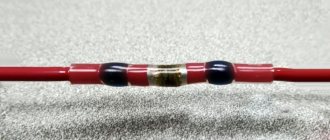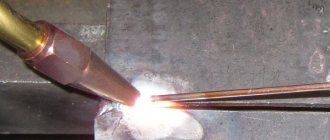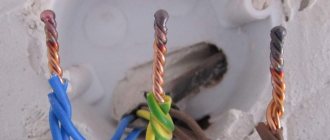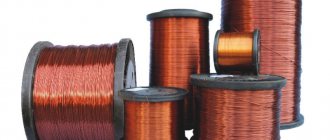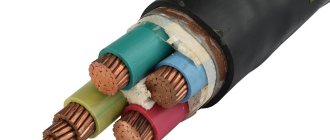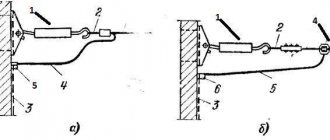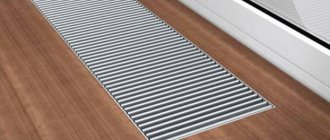Aluminum conducts current and is one of the best conductors in existence. It is used to make conductive busbars, cable lugs and sleeves, cable for overhead power lines, self-supporting insulated wire (self-supporting insulated wire) and wires of smaller cross-section (for domestic or industrial needs), coaxial television cable.
Metal resistance
Aluminum conducts current well; it is a metal with a low specific gravity and can be easily cast and processed in other ways. The electrical conductivity indicator puts it in 4th place, second only to silver, copper and gold.
Interesting! Although aluminum is better than copper in a number of characteristics, in long-term use it is not so preferable due to its high fragility and brittleness.
Regarding the resistance indicator of aluminum, 2 terms are distinguished in the electrical industry:
The value of electrical conductivity, the value of which characterizes the speed of transmission of electric current from point “A” to point “B”. The higher the number, the better the metal transports voltage. For example, at a temperature of 20°C, copper has a value of 59.5 million cm/m (Siemens per meter). Aluminum is only 38 million cm/m. Electrical resistance indicator. The higher the value, the more difficult it is to transmit electricity. The specific indicator of copper wire is 1.01724-0.0180 μOhm/m (microOhm - meter), aluminum - 0.0262-0.0295 μOhm/m.
Important! In a word, aluminum is a good conductor of current. It has excellent conductivity and resistance, but is still inferior to copper.
Other properties
Today, aluminum is produced almost twice as much as copper. And in comparison with all mined metals, it is second only to steel. This confirms that every year the electrical industry is increasing its use. This is explained by a number of reasons, which we will consider further.
Electrical performance of aluminum
According to the International Annealed Copper Standard (IACS), the latter is rated as 100% conductive. According to the above information, aluminum conducts electricity at only 61% equivalent to the generally accepted standard.
Thus, an equal percentage will only be achieved with larger cross sections. Since copper is significantly heavier than aluminum, such an “increased” conductor in mass will still be lighter than copper.
This fact has been proven through complex mathematical calculations, the result of which shows that 1 kg. aluminum provides equal conduction speed to that of 2 kg. copper Therefore, if certain technical conditions for the size of conductors do not require this, copper is replaced with aluminum.
Healthy! If for use in home wiring the weight of an electric wire does not have a special role, then when used on overhead power lines (overhead power lines), the weight of the current-carrying conductors has a significant effect. Therefore, take the one that is lighter, that is, aluminum.
Strength index
Provided the cross-section is the same, copper conductors are stronger than aluminum conductors. Although, this figure can be easily increased by alloying or thermomechanical treatment, or by increasing the cross-section.
The values given in the table show that aluminum conducts current, but is inferior to copper in terms of “break strength”. However, it is able to withstand its own weight and does not overload the overhead power line supports as much as copper.
In addition, extruding aluminum involves obtaining cross-sections of complex shapes, which cannot be obtained from steel. Based on such objective reasons, new elements can be designed in such a way that they will be the most effective in comparison with acceptable analogues from other materials.
Corrosion resistance
Aluminum does not require additional painting or zinc coating to protect against corrosion. The natural oxide coating protects the metal from subsequent contact with oxygen in the air and prevents further oxidation.
Interesting! If the protective oxide layer is mechanically damaged, it is instantly restored naturally
Life time
The duration of operation depends on a number of conditions. First of all, it is temperature and humidity. Although the official figures are 30 years for copper and 15 for aluminum, in practice cables last much longer. As an example, we can cite houses built by Stalin or Khrushchev. Some of them still have their original electrical wiring. However, official information is announced in precisely these terms.
Interesting! Sometimes the opinion is expressed that such electrical wiring in the house is dangerous and can lead to fire as a result of overheating of the contacts. But this can happen to any metal, and the reason lies not in its properties, but in a poor connection or overload of the line. Similar incidents often happen in Soviet-built houses. When designing apartments in the 70-80s. of the last century, no one imagined that in a few decades they would be “filled” with electrical appliances requiring a larger cross-section.
A little historical background
Under the USSR, they didn’t ask which wire was better, copper or aluminum
, simply because copper was almost never used for electrical wiring. Many of us know from personal experience that in any house that is more than 15-20 years old, the main task of powering apartments is still performed by aluminum wires. By the way, the internal wiring is made of the same material, and this sometimes becomes a huge problem, but more on that below.
Under the Union, they did not always care about the quality of life of their citizens, so they could make products from cheaper ingredients, because the scale of savings within the vast country was impressive. To be objective, it should be said that few people planned to operate residential buildings not for 15-20 years, but for 30-40-50, and many of them will last a couple more decades. And replacing the collapsing wiring would be a simple matter - new, perhaps more comfortable buildings would still be built, and the power lines would not turn into an unpleasant and extremely dangerous “something.” In addition, at that time there were no such loads on power lines, which means there was no reason to put excess power into cables.
Advantages and disadvantages of aluminum wiring
The widespread use of aluminum wiring was practiced in old buildings. The main criterion in those days was easy availability and low cost of metal. The possibility of a lack of cable cross-section was not considered in those days due to the lack of electrical household appliances in the apartments of average citizens.
Positive factors
The low weight of aluminum wire makes it popular when installing high-voltage power lines. This condition has already been stated earlier, so let’s consider a number of other aspects:
Relatively low price of metal and products made from it. This factor plays a role when laying long lines. For example, to fully electrify a country house, more than 1,000 m of wire may be needed. Resistance to chemical oxidation. This condition is relevant given that the cores are hidden by plastic insulation. Durability of areas without insulation. As mentioned earlier, a protective film is formed on the surface of aluminum, which prevents the occurrence of oxidative processes.
Disadvantages of metal
Despite the fact that aluminum conducts current and has a whole range of distinctive characteristics, the widespread use of such wiring has not occurred for the following reasons:
The metal is characterized by a high resistivity with a corresponding tendency to heat and subsequent fire. In this regard, it is not recommended to use aluminum wire with a cross-section of less than 16 mm for electrifying a cottage. Under constant load (long-term connection of energy consumers), the contacts become loose. This fact is explained by the frequent heating and cooling of areas. Aluminum conductors break much faster as a result of bending, which significantly reduces their service life.
Advantages of aluminum wires
Despite a number of serious disadvantages, aluminum cables are still widely used for both domestic and professional purposes, despite a number of legal restrictions. And this is understandable if you look at the list of their main advantages:
- weight
. The specific gravity of aluminum is 2.7 g/cm3, and its “competitor” for cable products, copper, is 8.96 g/cm3. It’s hard to disagree that it is much easier to transport, unload and roll out a coil, drum or coil of lighter metal. If we are talking about kilometers of cable products, for example, for the installation of power lines, then the advantage becomes obvious, - price
. A powerful argument when choosing material for cable products, especially in large-scale projects. According to market data, aluminum wire costs 4-5 times less than copper wire with similar technical parameters. For example, for 1 meter of copper VVG 4x4 (olzh) you would pay at least 96 rubles, while the price of AVVG 4x4 (olzh) is only 22 rubles.
Copper and aluminum
The need to replace a section of electrical wiring may arise under various circumstances (damage, installation of an additional branch, other reasons). In this situation, “copper to copper” or “copper to aluminum” is connected. Contacts made of different metals require special attention, and the reason lies in the following:
They differ in different resistivities. Even a tightly screwed contact will weaken over time due to aluminum's tendency to thermal expansion. Copper also has an oxide protective film. However, it differs from aluminum in different resistances, as a result of which this is reflected in an increase in the contact temperature.
Important! Connections under load can become a source of sparks, which negatively affects the conductor capacity and can cause a fire.
The connection of copper and aluminum wire is acceptable. However, to do this you must adhere to the following methods:
Pre-tin the copper with a soldering iron and solder. Treat the contact with a special anti-oxidation lubricant. Use special metal devices (adapters): “Nut”; Made of 3 parallel plates, in which a current-carrying core is laid between the outer ones; Self-clamping or screw terminal blocks; Crimping; Bolted connection; Spring terminals.
